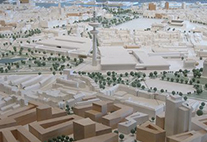Hamburg-based researchers are developing an environmental concept for “healthy cities” in an era of global change
20 August 2014, by Markus Dressel

Photo: H. Schlünzen
We’re living in the “century of the city”: more than half of the world’s populace ...
We’re living in the “century of the city”: more than half of the world’s populace now live in cities, and that number is growing. But cities not only offer appealing places to live; they can also harbor risks. In the future, climate change could make extreme weather events more frequent, endangering the countless people who live in cities. Having recognized that future-ready urban development has to take such factors into consideration, starting in January the State of Hamburg will sponsor a research project intended to identify optimal approaches and above all focusing on health. The project will be led by researchers at Universität Hamburg’s Center for Earth System Research and Sustainability (CEN).
The project “Cities in Flux – Developing a multi-sector urban development impact model” will bring together researchers from meteorology, geography, urban planning, medicine, the engineering sciences, mathematics and further fields. With this broad mix of researchers, who contribute insights from their respective disciplines, it will be possible to better grasp the interconnections and interrelations at work in urban systems. To promote that understanding, an interdisciplinary urban development model will be created that will combine findings from the social, natural and engineering sciences to identify the effects that cities have on their inhabitants.
“Cities have to be structured so that they can continue to function, even in the face of multiple adverse conditions – i.e., when extreme weather events combine with air pollution. This project is intended to find solutions for ensuring cities can rise to the challenge,” explains meteorologist Prof. Heinke Schlünzen from the CEN. Professor of Geography Jürgen Oßenbrügge also emphasizes the socio-economic perspective: “It’s not enough to calculate and model the impacts of extreme events; we also need to estimate what they’ll mean for the population in question. Safeguarding the well-being of the local citizens has to be one of the goals of sustainable urban development.” As such, the researchers have defined health and well-being as target parameters that depend on factors like noise pollution, air quality, temperatures and UV radiation.
“Using Hamburg as an example, we plan to develop a basic model that represents both urban development and the effects of the city,” explains Prof. Oßenbrügge. The model could subsequently be expanded to include additional parameters and applied to other cities around the world. The Hamburg State Research Foundation has allocated 1.2 million euros of funding for the project; the researchers involved plan to apply for additional funding in the form of a Collaborative Research Centre from the German Research Foundation (DFG) after three years’ time.
Universität Hamburg, the HafenCity University Hamburg, Helmholtz-Zentrum Geesthacht, Max-Planck Institute for Meteorology, Hamburg University of Technology (TUHH) and University Medical Center Hamburg-Eppendorf will participate in the project.
Contact:
Prof. Dr. Heinke Schlünzen
Centrum für Erdsystemforschung und Nachhaltigkeit
Bundesstraße 55
20146 Hamburg
E-Mail: heinke.schlünzen@uni-hamburg.de
Prof. Dr. Oßenbrügge
Centrum für Erdsystemforschung und Nachhaltigkeit
Bundesstraße 55
20146 Hamburg
E-Mail: ossenbruegge@geowiss.uni-hamburg.de
